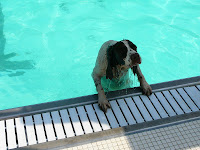
The first few bees of whom we asked the ultimate sacrifice refused.
Refused is too strong a word. They were indifferent to our inducements to Sting the Knee! Just do it!
The new knee has been rather stuff of late. This is probably entirely normal for a new titanium knee, and it could also be weather related. But I thought the time had come to try some Bee Venom Therapy (BVT). The theory, as I understand it, is that the venom in a bee sting releases the body’s natural cortisone. And cortisone is meant to be good for joint pains and stiffness.
Apicultural lore has it that beekeepers never get arthritis, on account of a lifetime of occasional bee stings.
 So we went out to one of the hives and CSB gently took one bee by the wing and placed her on my knee. Nothing. She sighed, if a bee can sigh. CSB prodded her nether parts against my skin, and still nothing. Finally he let her fly off, to live another day.
So we went out to one of the hives and CSB gently took one bee by the wing and placed her on my knee. Nothing. She sighed, if a bee can sigh. CSB prodded her nether parts against my skin, and still nothing. Finally he let her fly off, to live another day.We repeated this scenario five times before a bee was willing to extrude her stinger and inject me with venom. And though I’ve certainly been stung plenty of times over the past years, I have never watched quite so closely the emergence of the stinger, and then the extraction of the stinger from the bee’s small body, along with the thimbleful of white sticky goo which are her intestines.
The stinger and goo stayed behind on my knee, while she fell to the ground, dead.

After several more tries, one more bee was willing to sting me. I don’t know if the bees know that they will die once they sting. In the normal course a bee’s lifetime, she (the drones have no stingers) only stings in defense of the hive or in response to a perceived threat, and so it may be that some part of their DNA recognizes that defense of the hive is a deadly activity. Given that they function so seamlessly as a hive, given that they can give accurate directions, it is not impossible that the bees know this. Which would explain the resistance to stinging that has nothing to do with hive defense. Yet two bees did it.








































